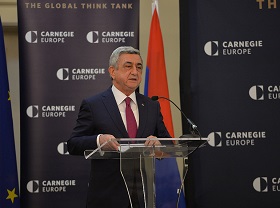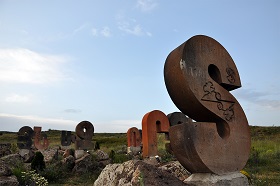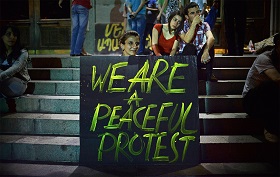On November 24, Armenia and the EU plan to sign a Comprehensive and Enhanced Partnership Agreement. The EU will provide Armenia with technological and financial assistance to modernize the state governance system, the power and transportation sector, and education. This agreement creates the pre-requisites for launching an EU–Armenia dialogue on liberalizing the visa regime. The model of Armenia’s Europeanization appears balanced. It both offers Armenia modernization options in certain strategic areas and takes into consideration the sociopolitical reality in Armenia itself, the absence of Yerevan’s clearly defined trade interests in its relations with the EU and its “special partnership” with Moscow.
The new agreement does not stipulate establishing an EU–Armenia free trade zone. For many reasons, Armenia’s President preferred integration into the EAEU to an association agreement with the EU. Benefits from rapprochement with Russia were far more tangible. Due to the economic recession in Russia, Yerevan’s financial and economic gains from its participation in the EAEU resulted to be far more moderate than had been envisioned.
As for the key aspects of the EAEU integration process (foreign trade policy, unification in technological, sanitary and phytosanitary regulations), these areas remain virtually unaffected by the new EU–Armenia agreement. The Eurasian Economic Commission heartily welcomed the new agreement which, in fact, brings the EAEU to its cherished goal of establishing full-fledged cooperation with the EU.
The new relations between Brussels and Yerevan do not greatly affect Russia’s energy interests in Armenia. The situation in the power sector is more complicated: it would be difficult to say that Russia could really claim dominance of Armenia’s power sector and contain liberalization in this area.
On November 24, 2017, Brussels will host the Eastern Partnership Summit. Armenia and the European Union are planning to sign the Comprehensive and Enhanced Partnership Agreement, initialed in March earlier this year. The instrument is a lite version of the association agreement the parties developed, but did not sign due to Yerevan’s 2013 decision to join Eurasian integration.
The agreement’s form and content are similar to association agreements Brussels signed with Georgia, Moldova, and Ukraine. It is not merely a list of general declarations on various subjects, but an instrument that lays out Yerevan’s specific commitments to harmonizing legislation with EU norms and standards. For instance, Armenia pledges to significantly harmonize its legislation with that of Europe in such areas as transportation, energy, telecommunications market, consumer rights protection, and social protection within a specific period (as a rule, between 3 and 8 years). The agreement’s annexes list specific directives and regulations the EU has adopted in these areas, which are to be fully or partially incorporated into Armenia’s national legislation.
In this regard, Armenian supporters of European integration wonder if the new undertaking is ambitious enough in bringing Armenia and the EU closer together and ensuring the modernization and Europeanization of the country. In turn, proponents of Armenia’s Eurasian integration see the instrument’s key aspect in the extent of its compatibility with Yerevan’s commitments within the EAEU and in Russia–Armenia bilateral relations.
Reasonable Europeanization
The new agreement is a good foundation for Yerevan’s closer interaction with the EU in several priority areas, primarily in the EU providing Armenia with technological and financial assistance in modernizing the state governance system, the power and transportation sector, and education.
First, institutional reforms are of crucial importance; given Armenia’s permanent budget deficit, the country has problems implementing them on its own. In particular, e-government technologies will be introduced with the EU’s assistance. Brussels also supports the modernization of Armenia’s border and customs control. Changes in border control management and the positive experience in implementing re-admission agreements and in simplifying the visa regime could, as the new agreement states, create pre-requisites for launching an EU–Armenia dialogue on liberalizing the visa regime.
Second, Yerevan and Brussels have already completed negotiations on connecting Armenia to the European airspace. The air transportation market in Armenia is poorly developed, and attracting foreign carriers, primarily low-cost airlines, will have a positive impact on consumers’ interests and on the tourist influx into the country.
Third, the agreement with the EU may advance Armenia’s energy security in the power sector in the medium and long term. For Armenia, the key problem in this regard is that the working power unit of Armenia’s nuclear power plant (NPP) should be decommissioned starting in 2026; currently it accounts for about 40% of the country’s power needs and is still the key resource in ensuring Armenia’s energy security given the country’s complicated relations with Azerbaijan and Turkey. Consequently, Armenia needs to either find money to build a new nuclear power plant or put new power facilities into operation, particularly hydropower ones, and create conditions for importing power from neighboring Georgia.
Brussels introduced a stipulation in the 2006 EU–Armenia Action Plan that Armenia’s NPP should be decommissioned as soon as possible; the European Commission deems it unsafe due to seismic conditions. This stipulation is repeated in the Comprehensive and Enhanced Partnership Agreement. Since constructing a new NPP would require at least 5 billion dollars in investment, Armenia prioritizes developing other energy sources. In this respect, rapprochement with the EU could be beneficial in several aspects. Armenia pledges to implement the so-called Third Energy Package, which may help to make Armenia’s power market more competitive and attractive for investors. The country has great potential for developing hydropower, and American companies are already active in this area. In addition, the European Union is willing to offer at least minimal technical assistance in the possible construction of a power interconnector that would link the power systems of Armenia and Georgia. Such an interconnection would allow Armenia to overcome the isolation of its power system and ensure power imports should such a need arise.
Fourth, the European Union is increasing grant support for Armenia in implementing regional development projects and academic projects under the Horizon 2020 program.
We can see that the new agreement does not stipulate the establishment of an EU–Armenia free trade zone. It would seemingly mean lost profits in Armenia from increasing its exports to EU markets and borrowing European market institution practices. However, it appears that Armenia’s possible gains in this regard are rather illusory for now. European statistics shows that over the last ten years, despite the GSP+ trade preference system, Armenia, unlike, for instance, Moldova, has not boosted its exports to the EU (340 million euros in 2006 and 335 million euros in 2016).
In addition, Armenia mostly exports low-processed goods to the EU, such as raw materials (primarily copper and molybdenum ores as well as cut diamonds) and textiles manufactured under tolling agreements. It is unlikely that other traditional Armenian exports (fruits and vegetable or alcohol products) could greatly improve their positions on European markets in the foreseeable future. Russia and Iran are likelier markets for such goods. Moreover, it is unlikely that Armenia could fully borrow the necessary market institutions that would advance national exporters’ competitive edge given the current level of corruption and the shadow economy in the country, the dominance of the security agenda, and a lack of EU membership prospects.
It is thus clear why Armenia’s president preferred integration into the EAEU to an association agreement with the EU. It is not a matter of Moscow allegedly putting pressure on Yerevan in 2013, as European experts often say; it is a matter of the benefits of rapprochement with Russia being far more tangible. As can be seen from the joint statement adopted after a meeting between Serzh Sargsyan and Vladimir Putin in September 2013, Moscow made Yerevan a very lucrative offer.
First, Armenia received certain political guarantees on Nagorno-Karabakh. In particular, “improved interaction” in military technical cooperation resulted in Moscow assisting Yerevan in restoring a strategic balance in its confrontation with Azerbaijan; the balance had been shaken by Baku actively purchasing weapons in the 2010s. Russia offered Yerevan weapons for purchase at Russia’s domestic prices and via a simplified procedure (without an export license) and offered a reduced-rate loan of US $ 200 million for this purpose. In September 2016, Armenia received the Iskander missile system that could act as deterrent against possible offensives by Azerbaijan.
Second, Yerevan was offered a close partnership in the energy sector. Already in December 2013, the two countries’ governments signed an agreement on duty-free supplies of natural gas, petrochemicals, and uncut diamonds from Russia to Armenia; the goal was to make these kinds of strategic raw materials as cheap as possible for Armenia. In addition, Moscow was ready to ensure Armenia’s medium-term energy security by extending the operation of Armenia’s NPP until 2026. In 2015, Armenia received a loan of US $ 270 million for these purposes. Given the power deficit and high costs of other energy sources, extending the operation of Armenia’s NPP covers the country’s energy needs and gives Armenia’s government time to take decisive steps in overhauling the national power grid.
Third, Yerevan was to gain major benefits from EAEU integration as such. It meant not only increased exports of Armenian goods to the markets of the Union’s member countries, it also meant an increased quota in the distribution of customs payments and major financial and technological aid in implementing projects in regional development, modernizing customs infrastructure, and the certification system. However, due to the economic recession in Russia, Yerevan’s financial and economic benefits from its EAEU membership are far more moderate than had been envisioned.
One could say that the model of Armenia’s Europeanization as set forth in the Comprehensive and Enhanced Partnership Agreement is a balanced one. On the one hand, it offers Armenia modernization opportunities in certain strategic areas, such as liberalizing the air transportation market and the energy market and reforming the state governance system. On the other hand, it takes into consideration the sociopolitical reality in Armenia itself, the absence of Yerevan’s clearly defined trade interests in its relations with the EU, and its “special partnership” with Moscow.
In the orbit of the Eurasian project
Should the statement repeated throughout the Agreement on “recognizing the importance the Republic of Armenia attaches to its participation in international organizations and cooperation formats and its existing obligations arising therefrom” be trusted? How compatible is the Yerevan–EU agreement with Armenia’s commitments in its relations with the EAEU and Russia?
As for the key aspects of EAEU integration (foreign trade policy and unification in technological, sanitary, and phytosanitary regulations), these areas remain virtually unaffected by the new EU–Armenia agreement. In foreign trade, the parties mostly confirm the importance of trade liberalization agreements concluded within the WTO. As for technical regulations, the parties will “endeavor to establish and maintain a process through which gradual approximation of the technical regulations, standards, and conformity assessment procedures of the Republic of Armenia to those of the European Union can be achieved” (article 130), however no specific commitments are listed. The most general clauses are stipulated for sanitary and phytosanitary control. As a consequence, the Eurasian Economic Commission heartily welcomed the new agreement which, in fact, brings the EAEU to its cherished goal of establishing full-fledged cooperation with the EU.
As regards Russia’s energy interests in Armenia, the new level of Brussels–Yerevan relations hardly affects them. First, the Agreement does not in any way regulate the gas market, and the relevant EU gas directives from the so-called Third Energy Package are not mentioned in the text (in contrast with the EU association agreements with Georgia, Moldova, and Ukraine). Consequently, nothing threatens Gazprom’s positions in Armenia. Since Russia’s gas company is essentially the only possible supplier and given the situation in the region, real diversification of gas imports to Armenia is not likely a practicable task.
The situation in the power sector is more complicated. Moscow has demonstrated its interest in Armenia continuing to use nuclear power beyond 2026 on several occasions; it would be done, accordingly, with Russia’s direct involvement. The appropriate inter-governmental Russia–Armenia agreement was signed in August 2010, and Russia said it was ready to finance 20% of the construction of a new NPP unit. However, given the project’s high costs, the European Commission’s negative view of it, and the financial difficulties faced by Russia and Armenia, putting the 2010 inter-governmental agreement into practice will not likely be possible in the foreseeable future.
In addition, Russia’s Inter RAO sold its Armenian assets in 2015, which, given the complex economic situation, fits with the power company’s strategy of focusing on Russia’s power market. Under these circumstances, it would be difficult to say that Russia could really claim dominance of Armenia’s power sector and constrain liberalization in this area. This is why the norms of the Third Energy Package on regulating the power sector are included in the EU–Armenia Agreement, although the deadline for their implementation is set at eight years, while for certain aspects, no deadlines are set at all.
Consequently, one can see a high level of consistency in Armenia’s policies for participating in various integration formats and a consequential lack of major concerns regarding infringement upon Russia’s interests.







